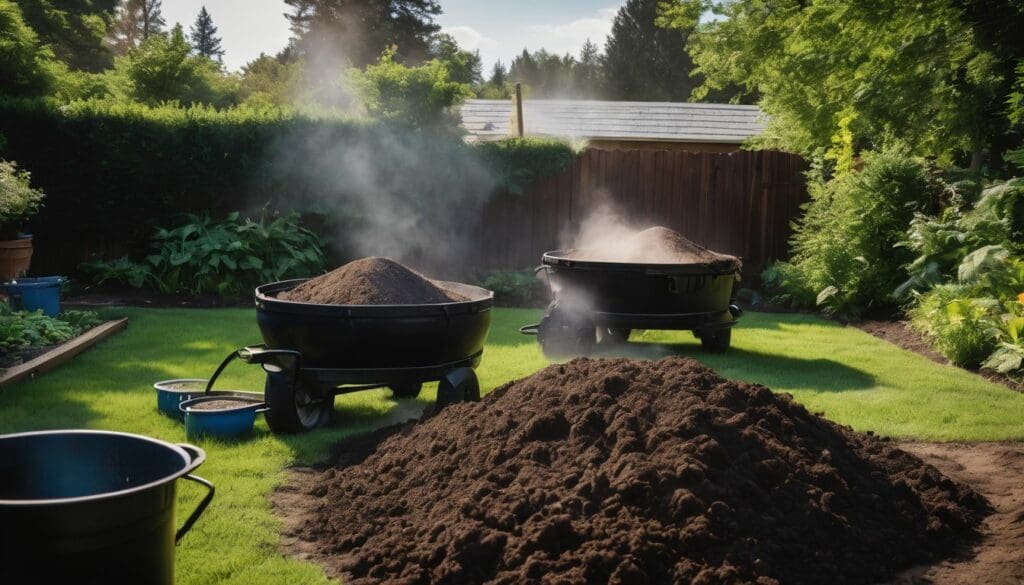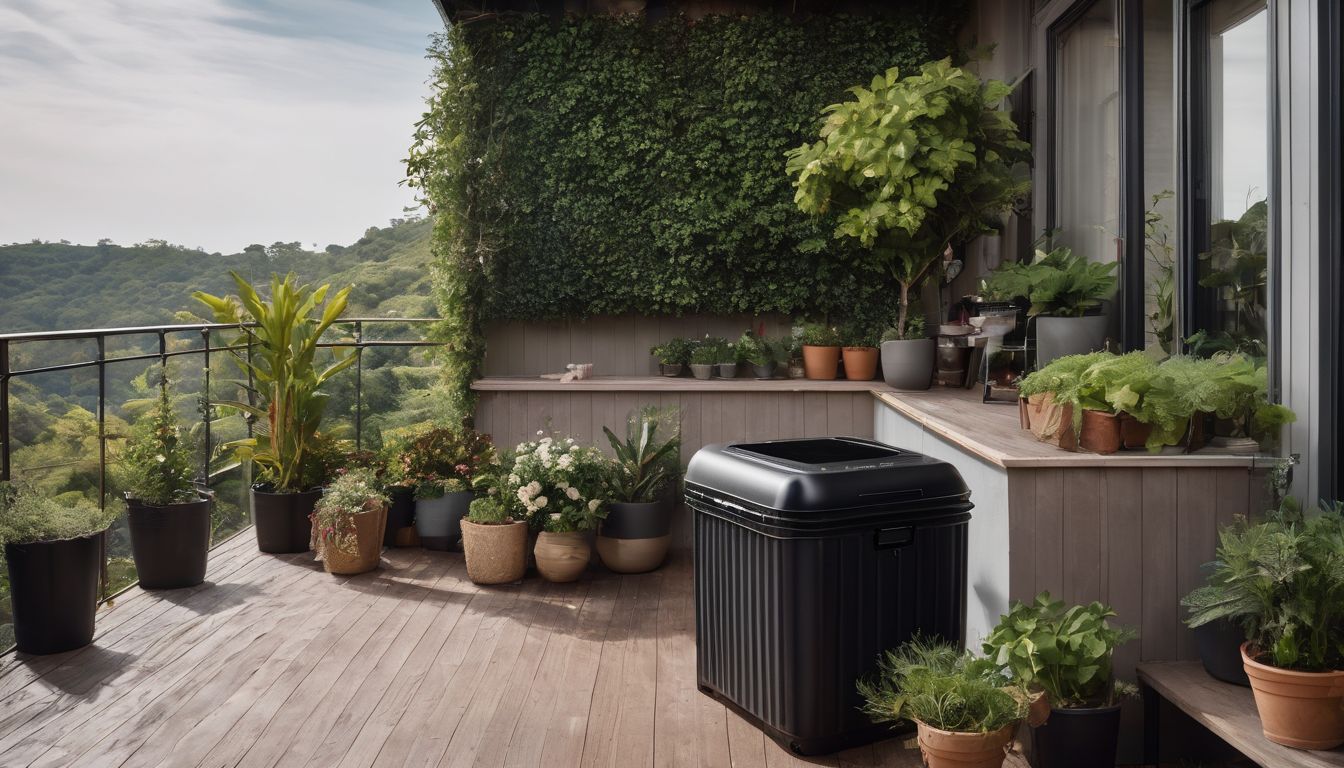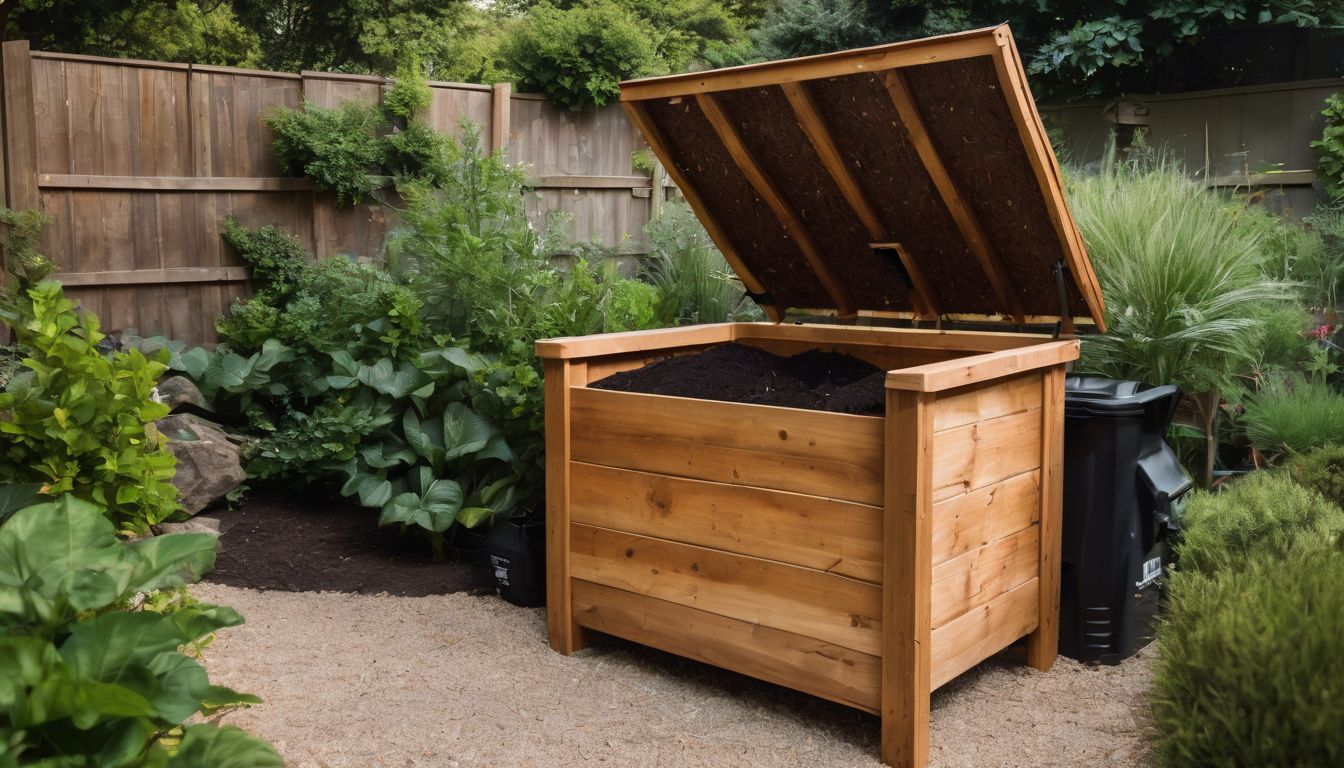Struggling to turn your kitchen scraps and garden waste into nutrient-rich soil? Composting is a brilliant solution, transforming organic matter into food for plants. This post delves into the pros and cons of hot versus cold composting, guiding you to choose the method that fits your green lifestyle.
Discover which composting warms up to your needs!
Key Takeaways
- Hot composting breaks down organic waste quickly, often within weeks to a few months, reaching temperatures of 49°C to 77°C which can kill weed seeds and harmful bacteria.
- Cold composting is a slower process that may take six months to a year or more but requires less attention and is suitable for individuals with smaller amounts of organic waste.
- Maintaining the right balance between carbon-rich and nitrogen-rich materials is crucial in both hot and cold composting methods to promote effective composting.
- While hot composting demands regular turning and temperature monitoring, cold composting allows for a more hands-off approach, letting nature gradually transform waste into soil.
- Choosing between hot and cold composting depends on your time availability, desired speed of obtaining the end product, volume of organic materials at hand, and preference for maintenance levels.
Differences Between Hot and Cold Composting
Hot composting processes organic waste at higher temperatures, resulting in a faster breakdown of materials and the elimination of weed seeds, pathogens, and bacteria. On the other hand, cold composting takes longer as it operates at lower temperatures and requires less attention during the composting process.
Speed of composting process
The speed at which composting happens can vary greatly between hot and cold methods. Hot composting is like a sprint, breaking down organic waste quickly—often within a few weeks to a couple of months.
You need the right balance of carbon-rich materials like leaves and nitrogen-rich materials such as kitchen scraps to fuel the microorganisms that generate heat. This method requires active management to maintain high temperatures around 49°C to 77°C, essential for fast decomposition.
In contrast, cold composting takes its time, resembling more of a marathon. There’s no rush with this passive process; it can take anywhere from six months to a year or even longer for your heap to transform into nutrient-rich soil.
Temperature control isn’t crucial here—the pile stays close to ambient air temperature—and you won’t need frequent turning or precise ratios of carbon and nitrogen. Patience is key since nature does most of the work over an extended period without active intervention from you.
Attention needed
Hot composting requires more attention than cold composting. Regular turning of the compost pile is crucial to maintain optimum conditions for decomposition. Monitoring the temperature of the pile and adjusting carbon and nitrogen ratios as needed are also important tasks.
In contrast, cold composting demands less frequent attention, making it a suitable option for individuals with limited time or those seeking a low-maintenance approach to composting.
The speed at which hot composting breaks down organic material necessitates regular monitoring and adjustment, while cold composting can proceed at a slower pace with minimal intervention.
Optimum ratio of carbon and nitrogen
To achieve optimal decomposition, maintain the correct balance of carbon and nitrogen materials in your compost pile. This ratio should be approximately 30 parts carbon to 1 part nitrogen, promoting the growth of microorganisms responsible for breaking down organic matter.
With an ideal carbon-to-nitrogen ratio, you ensure efficient composting and a nutrient-rich end product that can enhance your sustainable gardening practices.
Temperature differences
Transitioning from the ideal carbon and nitrogen ratio, it’s crucial to understand the temperature differences between hot and cold composting. In hot composting, temperatures can reach 130-160°F, which accelerates the decomposition process.
This high heat effectively eradicates weed seeds, pathogens, and harmful bacteria present in the organic material being composted.
Conversely, cold composting temperatures range around 70-90°F. While this method takes longer for organic materials to break down, it still effectively transforms waste into nutrient-rich soil.
Killing of weed seeds, pathogens, and bacteria
Hot composting can effectively kill weed seeds, pathogens, and bacteria due to the high temperatures reached during the process. The heat generated from the breakdown of organic materials helps eliminate these unwanted elements, resulting in a safer and more hygienic end product.
This natural purification process ensures that the finished compost is free from potentially harmful agents.
Cold composting may not reach high enough temperatures to reliably kill weed seeds, pathogens, and bacteria. However, over an extended period of time, some decomposition may occur that could help reduce these undesired elements.
Efficiency in breaking down herbicides and pesticides
After eliminating weed seeds, pathogens, and bacteria, the composting process also efficiently breaks down herbicides and pesticides. This occurs due to the high temperatures reached during hot composting, which accelerates the breakdown of these chemicals into safer compounds for the environment.
Microorganisms present in a well-maintained compost pile actively work to decompose and neutralise harmful substances like herbicides and pesticides, contributing to a healthier end product.
In addition to temperature control within the compost pile, aiding this process can be achieved by maintaining an optimal carbon-to-nitrogen ratio and ensuring proper aeration. These factors collectively contribute to creating nutrient-rich soil that is free from harmful chemical residues when using organic materials for hot composting.
Factors for Hot Composting
To achieve hot composting, it is essential to maintain a balance of carbon and nitrogen materials, ensure insulation to retain heat, and keep the pile moist. These factors contribute to the rapid breakdown of organic matter and the efficient elimination of weed seeds and pathogens.
Balance of carbon and nitrogen materials
To achieve successful hot composting, ensure a balance of carbon and nitrogen materials in your compost pile. This means mixing brown materials like dry leaves or straw with green materials such as food scraps or grass clippings.
Aim for a 30:1 carbon to nitrogen ratio to provide the right conditions for aerobic decomposition. This balance promotes efficient breakdown of organic matter, resulting in nutrient-rich soil for your garden.
For cold composting, the same principles apply – ensuring a good mix of carbon and nitrogen materials will help facilitate the breakdown process over time, albeit at lower temperatures.
Insulation
Insulation is crucial for hot composting, as it helps to maintain consistent high temperatures within the compost pile. This promotes the breakdown of organic materials and ensures effective elimination of weed seeds, pathogens, and bacteria.
Proper insulation also facilitates the efficient breakdown of herbicides and pesticides. By retaining heat, insulation supports an ideal environment for microorganisms to thrive and accelerate the decomposition process in a hot composting system.
When cold composting, insulation plays a less significant role due to lower temperature requirements. However, a well-insulated container or bin can still help to regulate temperatures and create an environment conducive to slower but steady decomposition of organic materials.
Moisture
To ensure a successful composting process, maintaining the right level of moisture is essential. The organic materials in your compost pile need to be moist like a wrung-out sponge; too dry, and decomposition slows down, too wet, and you risk creating a smelly anaerobic environment that will deter helpful microorganisms.
Moisture control also affects temperature regulation within your compost pile. A well-moistened heap promotes the growth of heat-generating bacteria essential for hot composting but should not become soggy as it would hinder airflow for cold composting.
Therefore, keeping an eye on your moisture levels ensures a healthy breakdown of organic matter, optimising nutrient-rich soil creation.
Smaller pieces of material
When composting materials, shredding them into smaller pieces makes the decomposition process more efficient. Smaller pieces increase the surface area exposed to bacteria and decomposers, speeding up the breakdown of organic matter.
This allows for better aeration and moisture distribution within the compost pile, facilitating a quicker and more thorough breakdown of materials such as kitchen scraps, yard waste, and other organic matter.
To achieve optimal composting results, ensuring that materials are cut or shredded into smaller pieces is essential. The increased surface area allows for improved microbial activity, leading to faster decomposition and ultimately contributing to nutrient-rich soil for gardening or landscaping needs.
Factors for Cold Composting
Cold composting involves maintaining a lower temperature in the compost pile, requiring less attention and resulting in a longer composting process. This method is suitable for those with more time on their hands and who prefer a hands-off approach to composting.
Not as hot temperature-wise
Cold composting operates at lower temperatures than hot composting. This slower process means less attention is needed, and the decomposition of organic materials takes longer. The lower temperatures can result in a more extended breakdown period, but it still effectively decomposes organic matter over time.
To achieve successful cold composting, consider the temperature differences between hot and cold methods.
Less attention needed
Cold composting requires less attention than hot composting. With its lower temperatures, the process doesn’t demand constant monitoring or frequent turning of the pile. This makes it a suitable option for individuals with busy schedules or those who prefer a low-maintenance composting method.
By allowing nature to take its course at a slower pace, cold composting offers an attractive option for those looking to reduce their environmental impact without dedicating significant time and effort.
When choosing between hot and cold composting methods, considering the amount of time available for tending to the pile is essential in making an informed decision. The next section will delve into factors influencing hot composting.
Longer composting process
Cold composting typically takes longer than hot composting due to lower temperatures. The slower breakdown of organic material means that the process may take several months to a year to yield nutrient-rich soil.
However, cold composting requires less attention and maintenance compared to hot composting, making it an accessible option for individuals with limited time or resources.
With cold composting, the natural decomposition process occurs at its own pace without the need for regular turning or monitoring of temperature levels. This method is suitable for those who are patient and seeking a more hands-off approach to creating compost from organic waste.
Choosing the Right Method for You
Consider your time availability, end product preferences, and the amount of materials you have when determining whether hot composting or cold composting is the right method for you.
Both methods have their own advantages and can produce nutrient-rich soil for your garden or crops.
Time availability
Consider your available time when choosing between hot and cold composting methods. Hot composting requires more attention and maintenance, as the compost pile needs to be turned regularly to maintain optimum conditions.
This method may not be suitable for individuals with limited time for frequent monitoring and management. On the other hand, cold composting is less demanding in terms of time as it can progress at its own pace without the need for constant intervention.
Depending on your schedule and availability, you can select a composting method that aligns with your lifestyle and time constraints. If you have limited time to dedicate to managing the compost pile, cold composting might be the more practical choice for creating nutrient-rich soil from organic materials without requiring regular upkeep.
End product preferences
Consider your end product preferences when choosing between hot and cold composting. If you desire a quicker turnaround, with high temperatures effectively breaking down materials, hot composting may be ideal.
This method produces nutrient-rich soil faster, which can benefit gardens or farms on a tight schedule. On the other hand, if time is not of the essence and you prefer a low-maintenance approach that produces less intense heat over an extended period, then cold composting might be the best fit for you.
When considering your end product preferences for composting methods, it’s essential to evaluate how each aligns with your desired outcome in terms of nutrient-rich soil production and time efficiency.
Amount of materials
When considering the amount of materials for hot or cold composting, it’s important to note that hot composting requires a larger volume of organic waste. This method is ideal for those with access to a significant amount of kitchen scraps, yard trimmings, and other green and brown materials.
Cold composting can work well for individuals with smaller amounts of organic waste, as it involves a more gradual breakdown process that accommodates lower quantities. Regardless of the method chosen, it’s essential to ensure a balanced mix of carbon-rich and nitrogen-rich materials to achieve successful decomposition.
For hot composting, you’ll need a substantial quantity of organic matter such as leaves, grass clippings, fruit and vegetable scraps along with other green and brown material layers.
Conclusion
In conclusion, hot composting and cold composting offer unique benefits. Hot composting requires more attention but produces nutrient-rich soil faster. Cold composting is less demanding and suits individuals with limited time.
Both methods contribute to waste reduction while enriching the environment. Choose the method that aligns best with your preferences and resources.
FAQs
1. What are the main differences between hot composting and cold composting?
Hot composting heats up the compost pile temperature to break down organic material faster, killing weed seeds and pathogens, while cold composting happens at lower temperatures over a longer time without the need for extra heat.
2. How does hot composting eliminate weed seeds and pathogens?
By maintaining a high compost temperature, usually between 135-160 degrees Fahrenheit, hot composting effectively eliminates most weed seeds along with harmful bacteria and pathogens from your pile.
3. Can both methods of composting handle herbicides and pesticides?
Yes, both hot and cold composting can breakdown residues of herbicides and pesticides in organic material but doing it at higher temperatures makes hot composing more efficient in this process.
4. Why is it important to control the temperature of my compost pile?
Controlling your pile’s temperature ensures that you’re using either hot or cold composter methods correctly to create nutrient-rich soil; too much heat can kill beneficial microbes while too little may not break down materials thoroughly.
5. What should I know about carbon-to-nitrogen ratio in my composter?
The carbon-to-nitrogen ratio is vital for successful decomposition; having a balanced mix helps bacteria thrive which speeds up breaking down matter into healthy soil whether you are doing hot or cold composition.





